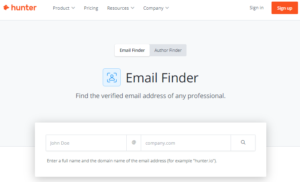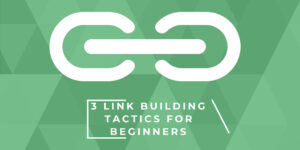Learning how to do blogger outreach that leads to backlinks is a very important thing to do when talking about how to build links to your site because nearly all link-building tactics require some sort of email exchange. The primary objective of blogger outreach is to convince those with large targeted audiences to talk about you. And from the perspective of an SEO, you want them to link to your website. Outreach doesn’t mean broadcasting, meaning you shouldn’t be sending every single person the exact same email as you would through email marketing.
For example, if you take a look at what a typical blogger outreach looks like today, you will see that they don’t even take a second to check what the name of the person they are reaching out to is, even when literarily most of their blog pages have their full name on them.
Instead, they stick with a generic term, then use it in a mass mailing software and send it out to hundreds, maybe even thousands of people. But the name thing isn’t that of a deal. Secondly, these generic template emails have zero consideration for the recipients. You will see things like, “I am writing because I saw your post here.” Then they wouldn’t even take a second to proofread the email. And their justification to get a backlink will always be because “it fits well in your post.”
On top of that, the person will still follow you up three to four more times with nearly the exact same email, all sent within the same time frame. This act is simply known as spam. And the result of these kinds of emails leads to nothing. These kinds of emails are prime examples of why you need to write good and quality emails. Otherwise, you will just blend in with the rest of the spam people get on a daily basis. After all, these are unsolicited emails.
Now to be clear, it doesn’t mean you can’t use some sort of template to send a lot of emails officially. Check out this email, for example:
Hey Bob
I just published a roundup post about the three best natural ways to get rid of acne, and I featured your work on carrier oils in it (link to post).
But I am not looking for a share or anything like that.
I just wanted to say thank you for all the inspiration you have brought to the health blogosphere and skincare world.
Best of luck in your endeavors, and keep up the good work on “pinkycare”.
Cheers
Mark
Looking at this email, it is evident that he did a bit of digging before sending the email, and I am sure he sent a similar message to all 19 people he featured. So you might be thinking: what’s the point of this email if he is not asking for anything? Well, at least that email accomplished the following:
- His email was opened and read
- I responded to him and said thanks for the mention.
- Should he email me again, I will probably open it because I will recognize his name.
Now, the first email that I just showed you is one of the common approaches to blogger outreach. It’s called “the shotgun approach,” where you build a broad list of targets, load them up into an outreach tool, and then blast out emails to anyone and everyone. The opposite approach to this is the sniper method.
The sniper method is when you choose targets carefully based on a tight set of criteria and then send personalized emails. Of the two methods, we recommend going with the sniper method because shotgunning emails to anyone and everyone is a surefire way to burn bridges. Plus, no one likes spam. For that reason, the rest of this lesson will be centered on the sniper approach.
Before we get into actually crafting your outreach emails, let’s quickly talk about who you should be contacting and how to get their email addresses. In general, you will want to contact the author of the post if they work for the website. But in a case where the author doesn’t work for the website, there wouldn’t be any use in contacting him. In this case, you would want to contact the editor of the blog.
To find who that person is, you can check places like the websites about or team page, and their write for us page if they have one, or their company LinkedIn profile. Now to actually find the person’s email address, the easiest way is to check contact and about pages. This works best for websites with one author.
For websites that have multiple people involved, you usually won’t find individuals’ email addresses on their site. So to find these emails, you can use a tool like Hunter.io, sign up with them or click on the product option on the home page and you will see a drop-down then select the email finder tool, and just search for their first and last name as well as the domain.

Hunter will then give you their best guess. In some cases, they are wrong, but the success rate is generally quite high. Alright, so if you have chosen one of the three link-building tactics I outlined, created a list of prospects, vetted your list, and found some email addresses. It’s time to write the pitch.
While there isn’t exactly a streamlined formula for every outreach email you send, I want to talk about the anatomy of a simple email outreach that has been effectively practiced for years.
There are five main parts to a typical outreach email, and they are
- The subject line
- The Introduction
- Qualification and justification
- The pitch
- Continue the conversation
-
The subject line
The goal of the subject line is simply to get the person you are writing to open the email. Otherwise, there is no chance of getting a response. But you don’t want to clickbait them because that will only leave a bad impression. So when you are writing a subject line, you want to briefly and accurately describe why you are emailing them and ideally evoke curiosity.
For example, if we look at this guest blogging outreach email below, it shows a hypothetical pitch where I asked if I could write a post for a hockey site and share the data I have on the top 7 best hockey balls for 2022.
“Hey Frank
I was digging through your site and saw that you have a couple of posts on the best hockey balls for kids and distance. But I was pretty surprised to see that you don’t have one for the top 7 best field hockey balls for 2022.
Being a Beautician myself, I spent hundreds of dollars on balls and countless hours searching for the best hockey ball for me.
If you are open, I’d love to write a post for you about how to find the top 7 best hockey balls for 2022. I am happy to share all the data and stats, which I think will help people make an informed decision as they shop through your store.
Is that something you would be open to?
Cheers,
So I might use a subject line like: “new data: top 7 best hockey balls for 2022.” In my opinion, the “new data” part evokes curiosity, and the rest of the subject line explains the topic of the email.
-
The Introduction
While there are numerous ways to write an introduction, I think it’s best to start by telling them why you are emailing them. The aim of this part is to get them to read the best part of the email. For example, with the guest posting sample email above, it said:
“I was digging through your site and saw that you have a couple of posts on the best hockey balls for kids and for distance. But I was pretty surprised to see that you don’t have one for the top 7 best field hockey balls for 2022.”
Now I will admit that the first sentence could be more substantial, but I am basically saying that you have done this and this, but it looks like you are missing out on an opportunity here.
-
Qualification and justification
Asking someone for a favor and expecting them to see a mutual benefit is naïve. You need to show the person why you are qualified and justify the pitch. We will get to that in a second. “For example, if you are contacting someone to guest post, explain why they should accept your post over hundreds of other potential submissions. If you are asking them to add your link to a page on their site, give them an actual good reason why they should. So in our guest posting sample, you will see that I said:
“Being a Beautician myself, I spent hundreds of dollars on balls and countless hours searching for the best hockey ball for me.”
So the fact that:
- I mentioned I am a beautician and
- I have tasted numerous balls and got factual data for myself qualifies and justifies what I am about to pitch, which, again, is a guest post about top 7 best hockey balls for 2022.
Now, to drill in on the concept of qualification and justification, let’s look at an example email from the skyscraper technique. Let’s take this outreach email to get links to our blog post on the three best exercises to lose weight at home. So let’s email people with an email that looks something like this:
Hi [name]
I saw you mentioned that “an average of 5Kg is lost in 10 days with weight loss workouts at home” on your page about “At-Home Workouts to Lose Weight.” [Introduction: that’s our reason for contact]
That statistic is actually eight years old. More recent research (2022) suggests that one can lose 9Kg in 10 days working out at home. I think it’s higher because of the intensity and work-rest ratio of the exercise. [That’s our qualification and justification for what we are about to pitch]
We published this and a few other fresh workout tips and their rates of effectiveness here: [insert post link]
Not sure if you are actually editing posts, but it might be worth an update if you are? No pressure [the pitch].
Here the value proposition is that we are helping bloggers keep their content up to date.
-
The pitch
The pitch essentially includes your ask as well as your value proposition. Generally speaking, the stronger your value proposition, the higher the chance of getting a link.
[So for a guest posting example, you can say: If you are open, I’d love to write a post for you about how to find the top 7 best hockey balls for 2022]. I am happy to share all the data and stats, which I think will help people make an informed decision as they shop through your store [value proposition].
So not only are they getting data for free, but I am showing them how that can bring value to their bottom line.
-
Continue the conversation
I know you wouldn’t want to end your email with a cold hard pitch. The purpose of your first email should be to start a conversation. So you might say something like:
- Is that something you would be open to?
- Is there anything I missed?
- What do you think?
- Do you agree with our conclusion? And so on.
This is just a basic template you can use as you start blogger outreach. But I don’t want you to limit yourself to the above examples. All you are doing is talking to people and starting to build some kind of relationship. Just think about it as an in-person encounter.
You wouldn’t go to a bar and ask a stranger to buy you a drink. You might strike up a conversation, connect with them on a common interest, and maybe buy the first round of drinks expecting nothing in return. And as a result, they might want to reciprocate by returning an act of kindness.
Again, the goal of the very first email you sent is simple: start a conversation. While there will be times when it makes sense to ask for the link or guest posting opportunity right away, there are a lot of times when it makes more sense to just start that conversation and see where it leads.
The final tip I want to leave you with is to only use your best work when sending email pitches. You don’t want to email anyone and everyone for every single piece of content you create. For example, if you had a recipe blog and you created a post on a topic like “what is a Vegan Diet?” There is nothing interesting or unique about it, yet it’s still a topic you would probably want to cover. It would be tough to come up with a good reason for them to link to you on this topic. Plus, time is finite. So it’s worth doing outreach for your best content because there is a higher probability that it will result in backlinks.



